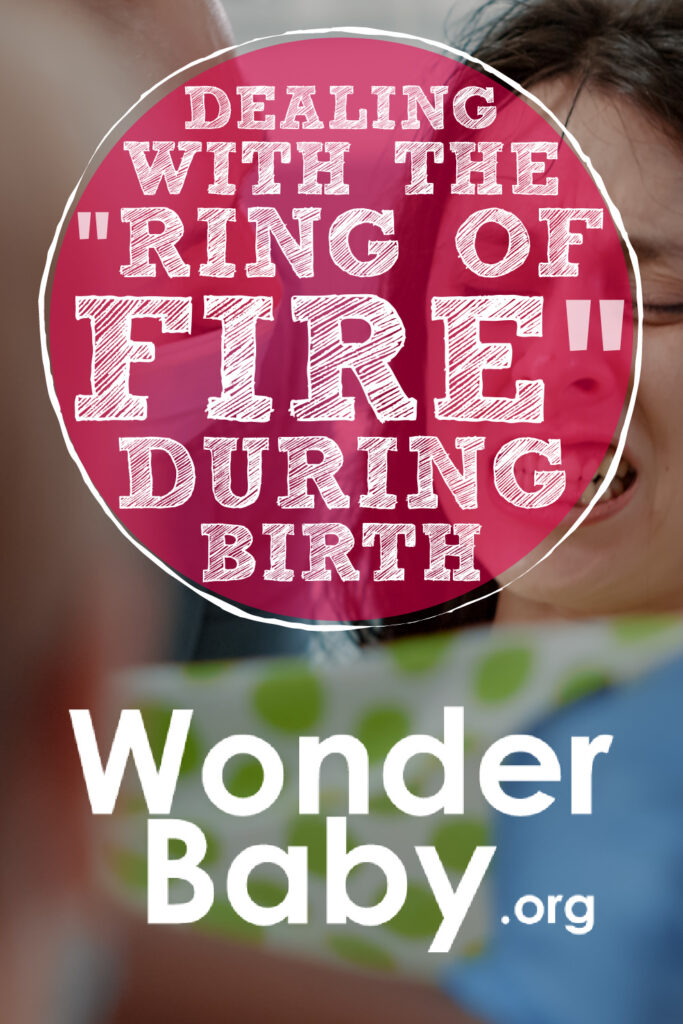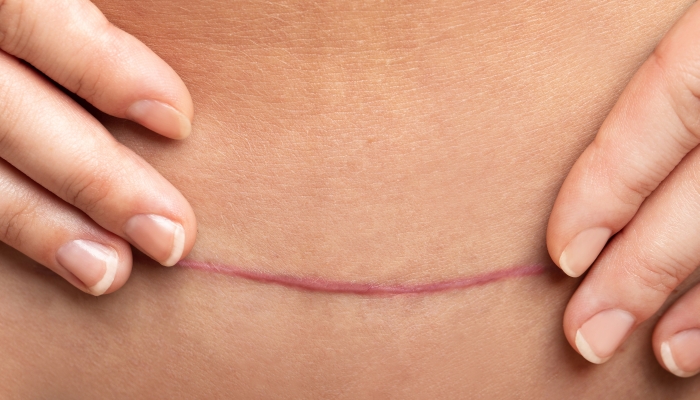Dealing With the “Ring of Fire” During Birth

- The ring of fire is pain caused by the baby’s head stretching the vaginal opening.
- You can help get through the ring of fire by choosing the best position for labor, using a perineal warm pack, or with perineal massage.
- A childbirth class can help you prepare for what you will do during the “ring of fire.”
- You may still experience the ring of fire with an epidural.
If you’re currently pregnant, you may be spending a lot of time researching and planning for your labor and delivery. The delivery of your baby is an exciting time.
During your research, you may have heard about the “ring of fire.” This is the big moment when your baby’s head first appears and he starts entering the world—it can be exciting, emotional, painful, and more than a little intimidating.
First-time moms and those who choose natural birth will need extra support dealing with the “ring of fire” during birth. Fortunately, there are a few things you can try that may help with minimizing the pain.
What Does It Mean to Experience a “Ring of Fire” During Birth?
The ring of fire is what many women describe as a burning sensation or stinging sensation during vaginal delivery. It’s known to be incredibly painful and is often considered the most difficult part of labor.
The ring of fire is something that most women experience during birth, especially mothers who choose to have an unmedicated delivery.
When Does the “Ring of Fire” Happen?
The “ring of fire” happens when your baby’s head begins to enter the vaginal opening. This is also known as the baby crowning. After you are fully dilated, your baby will enter the birth canal and make their way into this world. This is the time to really start to push.
What Does the “Ring of Fire” Feel Like?
Many women describe the ring of fire as a stinging or burning sensation. Some call it incredibly painful, while others may feel nothing. The stretch of the nerves during the ring of fire may even cause numbness.
If you get an epidural, you may feel nothing at all or you may feel some pressure as you need to push. Labor and delivery units and birthing centers will need to know ahead of time how you would prefer to manage your pain.

How Long Does the “Ring of Fire” Last?
This stage of labor can last anywhere from 2 minutes to 2 hours. If you have had an epidural, it is likely to be on the longer side. If you have already had multiple vaginal births, it will probably be shorter.
While not considered the “ring of fire,” you will probably continue to deal with some pain for several days to weeks after a vaginal delivery. Most women feel completely back to normal within 6 weeks of delivering their baby.
Can the “Ring of Fire” Be Avoided?
It may be possible! With proper preparation and good coaching, some women claim that they can completely avoid the ring of fire, even during an unmedicated birth. Mothers who choose strong epidural medicine may not experience the ring of fire when they deliver their baby.
What Can You Do to Avoid the “Ring of Fire” When Giving Birth?
Your labor and delivery nurse, obstetrician, or midwife may have some good strategies to help you avoid the ring of fire. They may suggest a perineal massage to help soften the vaginal opening and help reduce the fire sensation. You can also try different birthing positions like a semi sitting position to reduce perineal trauma or perineal injury.
There are several other options that may help to reduce the ring of fire during birth.
Warm Pack
Just like any other sore muscle or tissues, a warm pack can relieve pain and help you relax. Moist heat is even better and helps soften the perineal tissue. Ask your partner, doula, or labor and delivery nurse if they can get you a heat pack or warm towels to place on your perineum.
Perineal Massage
Perineal massage helps loosen the area and prepare it to stretch during delivery.
Your perineum is the space between your vagina and anus. A perineal massage can be done by yourself or your partner towards the end of your pregnancy, usually around 35 weeks. Try to massage the area 3 or 4 times per week.
Position
If you are uncomfortable, you can always ask your care team to help you into a different position. Position changes may be limited if you get an epidural, because you won’t be able to stand or balance very well.
A few different positions you can try include side lying, being on all fours, or sitting upright. Communicate with your care team about which position is the most comfortable for you. While some people prefer the traditional lying down knee holding position, not everyone finds this position comfortable.
Breathing Techniques
When you start to feel the ring of fire, you may also feel a strong sensation to start pushing. If you can breathe through it and try to relax, you’ll have less chance of tearing and less pain. Pushing too early doesn’t give your body enough time to stretch the tissue around your vaginal opening and allow it to expand.
Breathing techniques might include belly breathing or pant pant blow breathing.
Belly breathing is where you place one hand on your chest and one on your abdomen and breathe deeply, allowing your stomach to rise with each breath. Pant-pant-blow breathing happens when you inhale through your nose as your contraction starts, then exhale in two short pants followed by a blow.
Water Birth
While a water birth isn’t for everyone, there is research to show that water births are associated with less tearing and pain than natural land births. This may be due to the warm water relaxing the perineal tissue and the water helping mothers relax and avoid pushing too early.

How to Deal With the “Ring of Fire” During Birth
Even while using the best techniques, you may still experience the “ring of fire” during childbirth. You will need to know how to deal with the pain and push through when it happens.
Visualization and breathing techniques can help you cope with the pain of childbirth. Try to envision the goal—holding your new baby in your arms or bringing your baby home for the first time.
Another way you can deal with the pain is to create the least stressful environment possible in your delivery room. It’s okay to be picky about who you allow in the delivery suite. Don’t let anyone in who will cause you to stress or lose focus.
Some mothers choose to listen to music during labor. It doesn’t have to be classical or typical relaxing music either. Turn up your favorite rock band and really get into it.
Vaginal Tears
Vaginal tears are very common, ranging in severity from first degree to fourth degree. A 2010 study by Christine Kettle, Therese Dowswell, PhD, Khaled Ismail, MD, in Cochrane Database of Systematic Reviews states that 70% of women who have a vaginal birth will have some amount of tearing. Some can heal on their own with some rest, and others will need surgical repair.
Types of vaginal tears include:
- First degree: First degree tears involve just the skin of the perineum. These may heal on their own or require one or two stitches. Generally, they cause some painful urination for a few days after birth.
- Second degree: Second degree tears involve the perineum as well as some vaginal tissue. These tears will require at least a few stitches and take several weeks to heal completely.
- Third degree: Third degree tears involve the perineum, vagina, and the muscle surrounding the anus. These tears require surgery and take several weeks to months to heal.
- Fourth degree: Fourth degree tears involve the perineum, vagina, muscle surrounding the anus, and the mucous membrane of the rectum. As the most serious tear, they always require surgery.
FAQs
What are the three stages of labor?
The three stages of labor include: contractions, childbirth, and the delivery of the placenta.
The first stage begins with contractions and ends when your cervix is completely dilated and effaced. The second stage starts with full effacement and ends when the baby is delivered. The third stage begins right after baby is delivered and ends when the placenta comes out.
Will you still feel the “ring of fire” during an epidural birth?
Depending on your epidural, you may still feel a ring of fire. Many epidurals are run through a patient-controlled anesthesia pump, where you can press a button a certain amount of times to get more medication if you need it. That way, you have a little control over how much or how little you would like to feel.

The information WonderBaby provides is not intended to be, and does not constitute, medical or other health advice or diagnosis and should not be used as such. Always consult with a qualified medical professional about your specific circumstances.
Related Posts

Pregnancy
How To Deal With an Ingrown Hair on a C-Section Scar
Ingrown hairs on a C-section scar can be treated using a warm compress or mild exfoliation. Infected ingrown hairs may require antibiotic treatment.

Pregnancy
What’s a Dye Stealer Pregnancy Test?
A dye stealer pregnancy test usually means that your hCG levels are very high, which is typically considered a good sign for pregnancy.

Pregnancy
Can Yelling Cause a Miscarriage?
Yelling alone can not cause a miscarriage. However, maternal stress can cause high blood pressure, preterm labor, and other health problems.